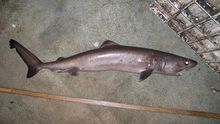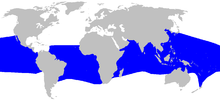Crocodile shark
| Crocodile shark | |
|---|---|

| |
| Scientific classification | |
| Domain: | Eukaryota |
| Kingdom: | Animalia |
| Phylum: | Chordata |
| Class: | Chondrichthyes |
| Subclass: | Elasmobranchii |
| Subdivision: | Selachimorpha |
| Order: | Lamniformes |
| Family: | Pseudocarchariidae Compagno,1973 |
| Genus: | Pseudocarcharias Cadenat,1963 |
| Species: | P. kamoharai
|
| Binomial name | |
| Pseudocarcharias kamoharai (Matsubara,1937)
| |

| |
| Range of the crocodile shark | |
| Synonyms | |
|
Carcharias kamoharaiMatsubara, 1936 | |
Thecrocodile shark(Pseudocarcharias kamoharai) is a species ofmackerel sharkand the onlyextantmember of the familyPseudocarchariidae.A specialized inhabitant of themesopelagic zone,the crocodile shark can be found worldwide intropicalwaters from the surface to a depth of 590 m (1,940 ft). It performs adiel vertical migration,staying below a depth of 200 m (660 ft) during the day and ascending into shallower water at night to feed. Typically measuring only 1 m (3.3 ft) in length, the crocodile shark is the smallest livingmackerel shark.It can be distinguished by its elongated cigar-shaped body, extremely large eyes, and relatively small fins.
An active-swimmingpredatorof pelagicbony fishes,squidandshrimp,the crocodile shark has a sizable oilyliverthat allows it to maintain its position in thewater columnwith minimal effort. The size and structure of its eyes suggests that it isadaptedfor hunting at night. The crocodile shark isaplacental viviparous,with females typically giving birth to litters of four. Thefetusesareoophagous,meaning that they feed on undeveloped eggsovulatedfor this purpose by their mother. Due to its small size, the crocodile shark poses little danger to humans and is of littlecommercialimportance. This species was responsible for damagingdeep sea fiberoptic cableswhen the technology was first deployed in 1985.
Taxonomy and phylogeny
[edit]TheEnglishcommon name"crocodile shark" is derived from itsJapanesenamemizuwani(Thủy ngạc,literally "watercrocodile"), which refers to its sharpteethand habit of snapping vigorously when taken out of the water.[2]Other common names for this species include Japanese ragged-tooth shark, Kamohara's sand-shark, and water crocodile.[3]The crocodile shark was first described asCarcharias kamoharaiin a 1936 issue ofZoological Magazine (Tokyo)byichthyologistKiyomatsu Matsubara, based on a 73.5 cm (28.9 in) long specimen found at the Koti Fish Market inJapan.[4]Thetype specimenis a 1 m (3.3 ft) long adult male found at a fish market inSu-ao,Taiwan.[5]
After being shuffled between the generaCarchariasandOdontaspisin the familyOdontaspididaeby various authors, in 1973Leonard Compagnoresurrected Jean Cadenat's 1963 subgenusPseudocarchariasfromsynonymyfor this species and placed it within its own family.[2][5]Themorphologyof the crocodile shark suggests affinity with themegamouth shark(Megachasmidae),basking shark(Cetorhinidae),thresher sharks(Alopiidae), andmackerel sharks(Lamnidae). More recentphylogeneticanalyses, based onmitochondrial DNA,have suggested that the crocodile shark is closely related to either the megamouth shark or thesand sharks(Odontaspididae). Alternately, analysis based ondentitionsuggests that the closest relatives of the crocodile shark are the thresher sharks, followed by the mackerel sharks.[5]FossilPseudocarchariasteeth dating to theSerravallianage (13.6–11.6Ma) of theMioceneepochhave been found inItaly,and are identical to those of the modern-day crocodile shark.[6]
Description
[edit]The crocodile shark has a spindle-shaped body with a short head and a bulbous, pointed snout. The eyes are very large and lacknictitating membranes(protective third eyelids). The five pairs ofgill slitsare long, extending onto thedorsalsurface. The sizable, arched jaws can be protruded almost to the tip of the snout and contain large teeth, shaped like spikes in the front and knives on the sides. There are fewer than 30 tooth rows in either jaw; in the upper jaw, the first two large teeth are separated from the lateral teeth by a row of small intermediate teeth.[5]
Thepectoral finsare small, broad, and rounded. Thepelvic finsare nearly as large as the pectorals. The firstdorsal finis small, low and angular; the second dorsal fin is smaller than the first but larger than theanal fin.Thecaudal finis asymmetrical with a moderately long upper lobe. Thecaudal peduncleis slightly compressed with weak lateral keels. Thedermal denticlesare small, with a flattened crown bearing small ridges and backward-pointing cusps[5]It is dark brown above and paler below, sometimes with a few dark blotches on the sides and belly and/or a white blotch between the corner of the mouth and the first gill slit. The fins have thin translucent to white margins.[7]The crocodile shark grows to a maximum length of 1.1 m (3.6 ft). Most individuals are 1 m (3.3 ft) long and weigh 4–6 kg (8.8–13.2 lb).[7]
-
The crocodile shark has a long body and small fins
-
Jaws
-
Upper teeth
-
Lower teeth
Distribution and habitat
[edit]The crocodile shark is almost circumtropical in distribution. In theAtlantic Ocean,it is known from offBrazil,Cape Verde,Guinea-Bissau,Guinea,Angola,South Africa,andSaint Helena Island,though it has not yet been reported from the northwestern Atlantic. In theIndian Ocean,it occurs in theMozambique Channeland possibly theAgulhas Currentand theBay of Bengal.In thePacific,it occurs fromJapan,Taiwan,and theKorean Peninsulain the northwest, southward toIndonesia,Australia,andNew Zealand,and eastward to the western coast of theAmericasfromBaja CaliforniatoChile,including theMarshall,Phoenix,Palmyra,Johnston,Marquesas,Line,andHawaiian Islandsin between.[5][8][9][10]In New Zealand this species has been recorded at the Three Kings Ridge, off the coast of Northland and on the northernKermadec Ridge.[11]
From distribution records, the crocodile shark's range seems to be bound by thelatitudes37°N and 44°S, where the averagesea surface temperatureis 20 °C (68 °F). This species is not evenly distributed but is rather locally abundant in certain areas, suggesting that it is not stronglymigratory.[12]The crocodile shark is usually found in thepelagic zonefrom the surface to a depth of 590 m (1,940 ft). It is occasionally encountered inshore near the bottom and has been known to strand on the beaches ofSouth Africa,possibly after being stunned by upwellings of cold water.[5]In March 2017, one crocodile shark washed ashore dead off the coast of Devon,Englandin Hope Cove, the first ever seen off the coasts of theUnited Kingdom.Thus far, it remains unknown as to why this particular shark was present so far north of its normal range.[13][14]
Biology and ecology
[edit]
With a long body, small fins, and largeliverrich insqualeneand other low-densitylipids,the crocodile shark isconvergently similartomesopelagicdogfish sharkssuch as thecookiecutter shark(Isistius brasiliensis). The liver may comprise a fifth of the shark's weight, and acts as an incompressible float that allows it to maintain neutralbuoyancyin the water column with little effort.[5][7]Like many other inhabitants of the mesopelagic zone, the crocodile shark apparentlymigratescloser to the surface at night to feed and descends into deeper water during the day, being rarely found above a depth of 200 m (660 ft) during daytime.[12]
The large eyes of the crocodile shark, equipped with a reflective green or yellowretinaand lacking an expandediris,suggest that it is anocturnalhunter that relies on sight to pick out the silhouettes orbioluminescenceof its prey.[7]Little is known of the crocodile shark's feeding habits; it is thought to be an active, fast-swimming predator based on its strong musculature, large tail, and behavior when captured. On one occasion, a crocodile shark offCape Point,South Africa,jumped out of the water in pursuit of bait. Itsdietconsists of small to medium-sizedbony fishes(includingbristlemouthsandlanternfishes),squid(includingonychoteuthids,mastigoteuthids,pholidoteuthids,andcranchiids) andshrimp.[5]Crocodile sharks are not known to be preyed upon by any other species.[12]
The crocodile shark isaplacental viviparousand typically gives birth to litters of four, two pups to eachuterus.Thegestation periodis unknown but believed to be long. Theembryoshaveyolk sacsat 3–4 cm (1.2–1.6 in) long; once the yolk sac is fully absorbed they becomeoophagous:the mother produces large numbers of thin-walled egg capsules that contain 2–9eggseach, which are then consumed by the unborn embryos. The abdomens of the embryos become characteristically distended with ingested yolk material, which can make up a quarter of the embryo's total weight.[15]It is unclear how two crocodile sharkfetusesmanage to share a single uterus, when in some other oophagous mackerel sharks such as thesand tiger shark(Carcharias taurus), only one fetus survives in each uterus. The pups are born at approximately 40 cm (16 in) long; males attain maturity at 74–110 cm (29–43.5 in) and females at 89–102 cm (35–40 in).[7]There is no defined reproductive season.[12]
Human interactions
[edit]
With its small size, non-cutting teeth, and oceanic habitat, the crocodile shark is not considered dangerous tohumans.However, it has a powerful bite that invites caution.[7]This species is a commonbycatchof variouspelagic longline fisheriesmeant fortunaandswordfish.The largest numbers are caught by the Japaneseyellowfin tunafishery and the Australian swordfish fishery, both operating in the Indian Ocean.[12]This species is also sometimes caught on squidjigsand in tunagillnets.[3][5]It is usually discarded due to its small size and low-qualitymeat.However, itsoilyliver is potentially valuable.[7]No data is available on the population status of the crocodile shark, though it is probably declining from bycatch mortality. Coupled with its low reproductive rate, this has led theInternational Union for Conservation of Nature(IUCN) to assessed it asNear Threatened.[1]In June 2018 the New ZealandDepartment of Conservationclassified the crocodile shark as "Data Deficient" with the qualifier "Secure Overseas" under theNew Zealand Threat Classification System.[16]
AfterAT&Tinstalled the firstdeep sea fiberoptic cablesbetweenGran CanariaandTenerifein theCanary Islandsin September 1985, the system suffered a series of shorts that necessitated costly repairs. It was discovered that attacks from the crocodile shark were responsible for most of the failures, possibly because they were attracted to theelectric fieldaround the cables. Since crocodile sharks are notbenthicin nature, they were presumably biting the cables as they were being deployed. The problem was solved by protecting the cables with a layer ofsteeltape beneath a densepolyethylenecoating.[7]
References
[edit]- ^abKyne, P.M.; Romanov, E.; Barreto, R.; Carlson, J.; Fernando, D.; Fordham, S.; Francis, M.P.; Jabado, R.W.; Liu, K.M.; Marshall, A.; Pacoureau, N.; Sherley, R.B. (2019)."Pseudocarcharias kamoharai".IUCN Red List of Threatened Species.2019:e.T39337A171964644.doi:10.2305/IUCN.UK.2019-1.RLTS.T39337A171964644.en.Retrieved18 November2021.
- ^abMartin, R.A.Pseudocarchariidae.ReefQuest Centre for Shark Research.Retrieved on December 24, 2008.
- ^abFroese, Rainer; Pauly, Daniel (eds.) (2008)."Pseudocarcharias kamoharai"inFishBase.December 2008 version.
- ^Matsubara K. (1936). "A new carcharoid shark found in Japan".Zoological Magazine (Tokyo)(in Japanese).48(7): 380–382.
- ^abcdefghijCompagno, L.J.V. (2002).Sharks of the World: An Annotated and Illustrated Catalogue of Shark Species Known to Date (Volume 2).Rome:Food and Agriculture Organization of the United Nations.pp. 71–74.ISBN92-5-104543-7.
- ^Cigala-Fulgosi, F. (1992). "Additions to the fish fauna of the Italian Miocene. The occurrence ofPseudocarcharias(Chondrichthys, Pseudocarchariidae) in the lower Serravallian of Parma Province, Northern Apenniens ".Tertiary Research.14(2): 51–60.
- ^abcdefghMartin, R.A.Biology of the Crocodile Shark (Pseudocarcharias kamoharai).ReefQuest Centre for Shark Research.Retrieved on December 24, 2008.
- ^Edwards, A.J. (1993). "New records of fishes from the Bonaparte Seamount and Saint Helena Island, South Atlantic".Journal of Natural History.27(2): 493–503.doi:10.1080/00222939300770241.
- ^Long, D.J.; Seigel, J.A. (1997). "A crocodile sharkPseudocarcharias kamoharai(Selachii: Lamnidae) from pelagic waters off Baja California, Mexico ".Oceanides.12(1): 61–63.
- ^Melendez, R.; Lopez, S.; Yanez, E. (2006). "New data ofPseudocarcharias kamoharai(Matsubara, 1936) (Chondrichthyes: Lamniformes: Pseudocarchariidae), off northern Chile ".Investigaciones Marinas Universidad Catolica de Valparaiso(in Spanish).34(2): 223–26.
- ^Roberts, Clive; Stewart, A. L.; Struthers, Carl D.; Barker, Jeremy; Kortet, Salme; Freeborn, Michelle (2015).The fishes of New Zealand.Vol. 2. Wellington, New Zealand: Te Papa Press. p. 63.ISBN9780994104168.OCLC908128805.
- ^abcdeRomanov, E.V., Ward, P., Levesque, J.C. and Lawrence, E. (2008). "Preliminary analysis of crocodile shark (Pseudocarcharias kamoharai) distribution and abundance trends in pelagic longline fisheries ".IOTC Working Party on Environment and Bycatch (WPEB) Bangkok, Thailand.
- ^"Rare crocodile shark discovered for first time in UK waters; photos | GrindTV".Archived fromthe originalon 2017-03-02.Retrieved2017-03-02.
- ^"Crocodile shark discovered on UK coastline for first time".Independent.co.uk.2 March 2017.
- ^Fujita, K. (May 1981). "Oviphagous embryos of the pseudocarchariid shark,Pseudocarcharias kamoharai,from the central Pacific ".Japanese Journal of Ichthyology.28(1): 37–44.
- ^Duffy, Clinton A. J.; Francis, Malcolm; Dunn, M. R.; Finucci, Brit; Ford, Richard; Hitchmough, Rod; Rolfe, Jeremy (2018).Conservation status of New Zealand chondrichthyans (chimaeras, sharks and rays), 2016(PDF).Wellington, New Zealand: Department of Conservation. p. 11.ISBN9781988514628.OCLC1042901090.
External links
[edit]- "Pseudocarcharias kamoharai,Crocodile shark "at FishBase
- "Biology of the Crocodile Shark" at ReefQuest Centre for Shark Research





